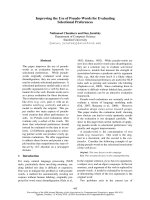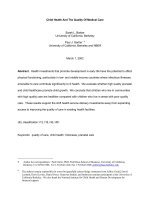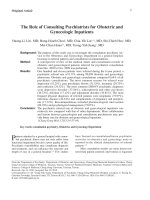Improving the Quality of Health Care for Mental and Substance-Use Conditions doc
Bạn đang xem bản rút gọn của tài liệu. Xem và tải ngay bản đầy đủ của tài liệu tại đây (1.65 MB, 529 trang )
Improving the Quality of
Health Care for Mental and
Substance-Use Conditions
Committee on Crossing the Quality Chasm: Adaptation to
Mental Health and Addictive Disorders
Board on Health Care Services
THE NATIONAL ACADEMIES PRESS
Washington, DC
www.nap.edu
THE NATIONAL ACADEMIES PRESS • 500 Fifth Street, N.W. • Washington, DC 20001
NOTICE: The project that is the subject of this report was approved by the Governing
Board of the National Research Council, whose members are drawn from the councils of
the National Academy of Sciences, the National Academy of Engineering, and the Institute of Medicine. The members of the committee responsible for the report were chosen
for their special competences and with regard for appropriate balance.
This study was supported by multiple contracts and grants between the National
Academy of Sciences and the Substance Abuse and Mental Health Services Administration (SAMHSA) of the Department of Health and Human Services (Contract No. 282-990045), the Robert Wood Johnson Foundation (Grant No. 048021), the Annie E. Casey
Foundation (Grant No. 204.0236), the National Institute on Drug Abuse and the National Institute on Alcohol Abuse and Alcoholism (Contract No. N01-OD-4-2139), the
Veterans Health Administration (Contract No. DHHS 223-01-2460/TO21), and through
a grant from the CIGNA Foundation. Any opinions, findings, conclusions, or recommendations expressed in this publication are those of the authors and do not necessarily
reflect the view of the organizations and agencies that provided support for this project.
Library of Congress Cataloging-in-Publication Data
Institute of Medicine (U.S.). Committee on Crossing the Quality Chasm:
Adaptation to Mental Health and Addictive Disorders.
Improving the quality of health care for mental and substance-use
conditions / Committee on Crossing the Quality Chasm: Adaptation to
Mental Health and Addictive Disorders, Board on Health Care Services.
p. ; cm. — (Quality chasm series)
Includes bibliographical references and index.
ISBN 0-309-10044-5 (full book)
1. Substance abuse—Treatment. 2. Community mental health services.
3. Substance abuse—Patients—Services for. I. Title. II. Series.
[DNLM: 1. Mental Disorders—therapy. 2. Substance-Related Disorders—therapy. 3. Patient-Centered Care. 4. Quality of Health Care.
WM 400 I59i 2006]
RC564.I47 2006
362.29—dc22
2005036202
Additional copies of this report are available from the National Academies Press, 500
Fifth Street, N.W., Lockbox 285, Washington, DC 20055; (800) 624-6242
or (202) 334-3313 (in the Washington metropolitan area); Internet, .
For more information about the Institute of Medicine, visit the IOM home page at:
www.iom.edu.
Copyright 2006 by the National Academy of Sciences. All rights reserved.
Printed in the United States of America.
The serpent has been a symbol of long life, healing, and knowledge among almost all
cultures and religions since the beginning of recorded history. The serpent adopted as a
logotype by the Institute of Medicine is a relief carving from ancient Greece, now held by
the Staatliche Museen in Berlin.
The National Academy of Sciences is a private, nonprofit, self-perpetuating society
of distinguished scholars engaged in scientific and engineering research, dedicated to
the furtherance of science and technology and to their use for the general welfare.
Upon the authority of the charter granted to it by the Congress in 1863, the Academy has a mandate that requires it to advise the federal government on scientific and
technical matters. Dr. Ralph J. Cicerone is president of the National Academy of
Sciences.
The National Academy of Engineering was established in 1964, under the charter of
the National Academy of Sciences, as a parallel organization of outstanding engineers. It is autonomous in its administration and in the selection of its members,
sharing with the National Academy of Sciences the responsibility for advising the
federal government. The National Academy of Engineering also sponsors engineering programs aimed at meeting national needs, encourages education and research,
and recognizes the superior achievements of engineers. Dr. Wm. A. Wulf is president
of the National Academy of Engineering.
The Institute of Medicine was established in 1970 by the National Academy of Sciences to secure the services of eminent members of appropriate professions in the
examination of policy matters pertaining to the health of the public. The Institute
acts under the responsibility given to the National Academy of Sciences by its congressional charter to be an adviser to the federal government and, upon its own
initiative, to identify issues of medical care, research, and education. Dr. Harvey V.
Fineberg is president of the Institute of Medicine.
The National Research Council was organized by the National Academy of Sciences
in 1916 to associate the broad community of science and technology with the
Academy’s purposes of furthering knowledge and advising the federal government.
Functioning in accordance with general policies determined by the Academy, the
Council has become the principal operating agency of both the National Academy of
Sciences and the National Academy of Engineering in providing services to the government, the public, and the scientific and engineering communities. The Council is
administered jointly by both Academies and the Institute of Medicine. Dr. Ralph J.
Cicerone and Dr. Wm. A. Wulf are chair and vice chair, respectively, of the National
Research Council.
www.national-academies.org
COMMITTEE ON CROSSING THE QUALITY CHASM:
ADAPTATION TO MENTAL HEALTH AND ADDICTIVE DISORDERS
MARY JANE ENGLAND (Chair), President, Regis College, Weston, MA
PAUL S. APPELBAUM, A.F. Zeleznik Distinguished Professor of
Psychiatry; Chairman of the Department of Psychiatry; and Director
of the Law and Psychiatry Program at the University of Massachusetts
Medical School, Worcester, MA
SETH BONDER, Consultant in Systems Engineering, Ann Arbor
ALLEN DANIELS, Professor of Clinical Psychiatry and Executive Vice
Chair, Department of Psychiatry, University of Cincinnati College of
Medicine, and CEO of Alliance Behavioral Care
BENJAMIN DRUSS, Rosalynn Carter Chair in Mental Health, Emory
University, Atlanta
SAUL FELDMAN, Chairman and Chief Executive Officer of United
Behavioral Health, San Francisco
RICHARD G. FRANK, Margaret T. Morris Professor of Health
Economics, Harvard Medical School, Boston, MA
THOMAS L. GARTHWAITE, Director and Chief Medical Officer, Los
Angeles County Department of Health Services
GARY GOTTLIEB, President of Brigham and Women’s Hospital, Boston,
and Professor of Psychiatry, Harvard Medical School, Boston, MA
KIMBERLY HOAGWOOD, Professor of Clinical Psychology in
Psychiatry, Columbia University and Director of Research on Child
and Adolescent Services for the Office of Mental Health in the State of
New York, New York City
JANE KNITZER, Director, National Center for Children in Poverty,
New York City
A. THOMAS MCLELLAN, Director, Treatment Research Institute,
Philadelphia
JEANNE MIRANDA, Professor, Department of Psychiatry and
Biobehavioral Sciences, University of California, Los Angeles
LISA MOJER-TORRES, Attorney in civil rights and health law,
Lawrenceville, NJ
HAROLD ALAN PINCUS, Professor and Vice Chair, Department of
Psychiatry, University of Pittsburgh School of Medicine, and Senior
Scientist and Director, RAND–University of Pittsburgh Health
Institute, the RAND Corporation
ESTELLE B. RICHMAN, Secretary, Pennsylvania Department of Public
Welfare, Harrisburg
v
JEFFREY H. SAMET, Professor of Medicine and Social and Behavioral
Sciences and Vice Chair for Public Health, Boston University Schools
of Medicine and Public Health and Chief, General Internal Medicine
at Boston Medical Center
TOM TRABIN, Consultant in behavioral health care and informatics,
El Cerrito, CA
MARK D. TRAIL, Chief of the Medical Assistance Plans, Georgia
Department of Community Health, Atlanta
ANN CATHERINE VEIERSTAHLER, Nurse, advocate, and person with
bipolar illness, Milwaukee, WI
CYNTHIA WAINSCOTT, Chair, National Mental Health Association,
Cartersville, GA
CONSTANCE WEISNER, Professor, Department of Psychiatry, University
of California, San Francisco, and Investigator, Division of Research,
Northern California Kaiser Permanente
Study Staff
ANN E. K. PAGE, Study Director and Senior Program Officer, Board on
Health Care Services
REBECCA BENSON, Senior Project Assistant (11/03–11/04)
RYAN PALUGOD, Senior Project Assistant (11/04–1/06)
Board on Health Care Services
JANET M. CORRIGAN, Director (11/03–5/05)
CLYDE BEHNEY, Acting Director (6/05–12/05)
JOHN RING, Director (12/05–)
ANTHONY BURTON, Administrative Assistant
TERESA REDD, Financial Associate
vi
Reviewers
This report has been reviewed in draft form by individuals chosen for
their diverse perspectives and technical expertise, in accordance with procedures approved by the NRC’s Report Review Committee. The purpose of
this independent review is to provide candid and critical comments that will
assist the institution in making its published report as sound as possible and
to ensure that the report meets institutional standards for objectivity, evidence, and responsiveness to the study charge. The review comments and
draft manuscript remain confidential to protect the integrity of the deliberative process. We wish to thank the following individuals for their review of
this report:
ALLEN DIETRICH, Dartmouth Medical School, Hanover, New
Hampshire
MICHAEL FITZPATRICK, National Alliance for the Mentally Ill,
Arlington, Virginia
HOWARD GOLDMAN, University of Maryland at Baltimore School
of Medicine
MICHAEL HOGAN, Ohio Department of Mental Health, Columbus
TEH-WEI HU, University of California, Berkeley School of Public
Health
EDWARD JONES, PacifiCare Behavioral Health, Van Nuys, California
DAVID LEWIS, Brown University Center for Alcohol and Addiction
Studies, Providence, Rhode Island
vii
viii
REVIEWERS
JOHN MONAHAN, University of Virginia School of Law,
Charlottesville
GAIL STUART, Medical University of South Carolina College of
Nursing, Charleston
MICHAEL TRUJILLO, University of New Mexico School of Medicine,
Albuquerque
WILLIAM WHITE, Port Charlotte, Florida
Although the reviewers listed above have provided many constructive
comments and suggestions, they were not asked to endorse the conclusions
or recommendations nor did they see the final draft of the report before its
release. The review of this report was overseen by FLOYD BLOOM, The
Scripps Research Institute and Neurome, Inc., La Jolla, California, and
JUDITH R. LAVE, University of Pittsburgh, Pennsylvania. Appointed by the
National Research Council and Institute of Medicine, they were responsible
for making certain that an independent examination of this report was carried out in accordance with institutional procedures and that all review comments were carefully considered. Responsibility for the final content of this
report rests entirely with the authoring committee and the institution.
Foreword
Improving the Quality of Health Care for Mental and Substance-Use
Conditions represents the intersection of two key developments now taking
place in health care. One is the increasing attention to improving the quality
of health care in ways that take account of patients’ preferences and values
along with scientific findings about effective care. The second important
development comes from scientific research that enables us to better understand and treat mental and substance-use conditions. New technologies such
as neuroimaging and genomics, for example, enable us to observe the brain
in action and examine the interplay of genetic and environmental factors in
mental and substance-use illnesses. These advances are potentially valuable
to the more than 10 percent of the U.S. population receiving health care for
mental and substance-use conditions; the many millions more who need but
do not receive such care; and their families and friends, employers, teachers,
and policy makers who encounter the effects of these illnesses in their personal lives, in the workplace, in schools, and in society at large.
This report puts forth an agenda for capitalizing on these two developments. Using the quality improvement framework contained in the predecessor Institute of Medicine report Crossing the Quality Chasm: A New
Health System for the 21st Century, it calls for action from clinicians, health
care organizations, purchasers, health plans, quality oversight organizations,
researchers, public policy makers, and others to ensure that individuals with
mental and substance-use health conditions receive the care that they need
to recover. Importantly, the report’s recommendations are not directed solely
to clinicians and organizations that specialize in the delivery of health care
for mental and substance-use conditions. As the report notes, the link be-
ix
x
FOREWORD
tween mental and substance-use problems and illnesses and general health
and health care is very strong. This is especially true with respect to chronic
illnesses, which now are the leading cause of illness, disability, and death in
the United States. As the committee that conducted this study concluded,
improving our nation’s general health and the quality problems of our general health care system depends upon equally attending to the quality problems in health care for mental and substance-use conditions. The committee
calls on primary care providers, other specialty health care providers, and
all components of our general health care system to attend to the mental and
substance-use health care needs of those they serve.
Dealing equally with health care for mental, substance-use, and general
health conditions requires a fundamental change in how we as a society and
health care system think about and respond to these problems and illnesses.
Mental and substance-use problems and illnesses should not be viewed as
separate from and unrelated to overall health and general health care. Building on this integrated concept, this report offers valuable guidance on how
all can help to achieve higher-quality health care for people with mental or
substance-use problems and illnesses. To this end, the Institute of Medicine
will itself seek to incorporate attention to issues in health care for mental
and substance-use problems and illnesses into its program of general health
studies.
Harvey V. Fineberg, MD, PhD
President, Institute of Medicine
Preface
The charge to the Committee on Crossing the Quality Chasm: Adaptation to Mental Health and Addictive Disorders was broad, encompassing
health care for both mental and substance-use conditions, the public and
private sectors, and the comprehensive range of issues addressed in the 2001
Institute of Medicine report Crossing the Quality Chasm: A New Health
System for the 21st Century. The committee was pleased to be asked to
address this breadth of issues. Despite the frequent co-occurrence of mental
and substance-use conditions, studies and reports that address both are unusual, as are those that cut across both the public and private sectors. We
are grateful to our sponsors for having the vision to recognize the need for
this study. Although the committee at times found the different histories,
vocabularies, and other characteristics of these groups of illnesses and delivery systems challenging, we also acknowledged the unique strengths that
each brought to the study, respected each others’ positions, and reached
consensus on issues that have traditionally been characterized by great disharmony. Having expertise in both mental and substance-use health care
and the perspectives of the public and private sectors at the table was essential to the committee’s efforts to craft a strategic agenda for improving the
quality of health care for mental and substance-use conditions for all. The
committee hopes that joint mental and substance-use studies and public–
private partnership initiatives will become routine.
Although the focus of this study was on solving the problems of health
care for mental and substance-use conditions—some of which are more complex than those associated with general health care—the committee also
recognized its strengths. Health care for mental and substance-use condi-
xi
xii
PREFACE
tions has led the way in promoting patient-centered care (a key quality aim
set forth in the Quality Chasm report) in a number of ways: through the
strong voice of consumers, their families, and consumer advocacy organizations in shaping mental health care; the long-standing use of peer support
programs in facilitating recovery from substance-use illnesses; and research
on how to enable decision making in the face of cognitive impairment. Moreover, the commitment and strength of the workforce delivering health care
for mental and substance-use conditions are remarkable. This workforce
has persevered in the face of limited attention to mental and substance-use
illnesses by health professions schools, constrained resources at care delivery sites, stigma and discrimination, and an inadequate overall infrastructure to support the delivery of high-quality treatment services. This report
identifies what it will take to build the needed infrastructure and fully support the workforce in delivering quality care.
This report also identifies gaps in our knowledge of how to effectively
prevent and treat mental and substance-use illnesses. While science has developed a strong armamentarium of effective psychosocial therapies and
medications for treating mental and substance-use problems and illnesses,
research is still needed to identify how best to meet the special needs of
children; older adults; individuals who are members of cultural or ethnic
minorities; and those with complex and co-occurring mental, substance-use,
and general health care illnesses. Moreover, translational research is needed
to determine how to apply existing knowledge in usual settings of care.
The agenda and road map the committee has outlined for building the
infrastructure needed to improve the quality of health care for mental and
substance-use conditions is comprehensive, demanding, and critically important. It is our hope that the government agencies, purchasers, health
plans, health care organizations, and other public- and private-sector leaders called upon to act on these recommendations will do so quickly so that
we, our loved ones, friends, coworkers—indeed all Americans—can receive
the high quality care for mental and substance-use conditions that is crucial
to overall good health.
Mary Jane England
Chair
Acknowledgments
The Committee on Crossing the Quality Chasm: Adaptation to Mental
Health and Addictive Disorders thanks the many individuals and organizations who so generously contributed their time, expertise, and sometimes
personal experiences to the development of this report. Foremost we thank
the consumers and their families who so eloquently testified to the committee about the power of good-quality health care to enable recovery from
mental and substance-use problems and illnesses. Nancy Fudge, participant
in the Florida Self-Directed Care Program; Michael M. Faenza, President
and CEO of the National Mental Health Association; Eileen White, on behalf of the National Alliance for the Mentally Ill; Jane A. Walker, Executive
Director of the Maryland Coalition of Families for Children’s Mental Health;
Johnny W. Allem, President of the Johnson Institute; Tom Leibfried, Program Director at the National Mental Health Consumers’ Self-Help Clearinghouse; E. Clark Ross, Chief Executive Officer of CHADD (Children and
Adults with Attention-Deficit/Hyperactivity Disorder); and Sue Bergeson,
Vice President of the Depression and Bipolar Support Alliance generously
shared their knowledge of mental and substance-use problems and illnesses,
health care for these conditions, and pathways to improvement based on
their own experiences and those of the individuals they represent.
Many other individuals and organizations provided testimony and other
assistance to the committee. We thank John Oldham, Chairman of the Council on Quality Care at the American Psychiatric Association; Jalie A. Tucker,
Chair of the Board of Professional Affairs at the American Psychological
Association; Wilma Townsend, on behalf of the National Alliance of
Multiethnic Behavioral Health Organizations; Allen J. Dietrich, represent-
xiii
xiv
ACKNOWLEDGMENTS
ing the American Academy of Family Physicians; Gerry Schmidt, Clinical
Affairs Consultant to NAADAC (the Association for Addiction Professionals); Ruth Hughes from the Substance Abuse and Mental Health Services
Administration’s (SAMHSA) Center for Mental Health Services Human Resources Work Group Alliance; Carolyn Russell, Director of the Florida SelfDirected Care Program; Jonathan Stanley, Assistant Director of the Treatment Advocacy Center; Linda Rosenberg, President and CEO of the
National Council for Community Behavioral Healthcare; Frank Ghinassi,
representing the National Association of Psychiatric Health Systems; Robert
Sheehan, President of the National Association for Children’s Behavioral
Health; Michael B. Harle, representing Therapeutic Communities of
America; Ronald J. Hunsicker, President and CEO of the National Association of Addiction Treatment Providers, Inc.; Marvin D. Seppala, representing the Partnership for Recovery; Wesley Sowers, President of the American
Association of Community Psychiatrists; Robert Booth, Executive Director
of the American Board of Examiners in Clinical Social Work; Mara Shrek,
also representing the American Board of Examiners in Clinical Social Work;
Elizabeth J. Clark, Executive Director, and Mickey J. W. Smith, Senior Policy
Associate, both of the National Association of Social Workers; William F.
Northey, Professional Development and Research Specialist at the American
Association for Marriage and Family Therapy; Sandra Talley, President of
the American Psychiatric Nurses Association; Thomas W. Nolan, Senior Fellow at the Institute for Healthcare Improvement; David H. Gustafson, Principal Investigator, Network for the Improvement of Addiction Treatment,
University of Wisconsin-Madison; Vijay Ganju, Director of the Center for
Mental Health Quality and Accountability at the National Association of
State Mental Health Program Directors Research Institute, Inc.; Robert
Johnson, representing the National Association of State Alcohol and Drug
Abuse Directors; Howard B. Shapiro, Executive Director of the State Associations of Addiction Services; Pamela Greenberg, Executive Director of the
American Managed Behavioral Healthcare Association; Melissa M. Staats,
Executive Director of the National Association of County Behavioral
Health Directors; Mark Willenbring, Director of the Division of Treatment
and Recovery Research at the National Institute on Alcohol Abuse and
Alcoholism; John A. Paton, representing the Software and Technology
Vendor’s Association; Lisa Teems, representing the Employee Assistance
Programs Alliance; Joan M. Pearson, Principal, Towers Perrin; Dale A.
Masi, President and CEO of Masi Research Consultants, Inc.; Neal Adams,
Medical Director for Adult Services, California Department of Mental
Health; Pamela S. Hyde, Secretary of the New Mexico Human Services
Department; Joy M. Grossman at the Center for Studying Health System
Change; Patricia A. Taylor, Executive Director of Faces & Voices of Recovery; Kevin D. Hennessey, Science to Service Coordinator at SAMHSA;
ACKNOWLEDGMENTS
xv
Sarah A. Wattenberg, Public Health Advisor at SAMHSA; and staff of the
Greater Los Angeles Veterans Healthcare Center EQUIP project and their
sponsors at the Veterans Administration Health Services Research & Development Service and Quality Enhancement Research Initiative.
Several national experts on topics relevant to the committee’s work also
provided invaluable assistance by preparing commissioned papers on the
issues under study. We thank Scott Y. H. Kim, MD, PhD, from the University of Michigan Medical School, for his paper on “Impact of Mental Illness
and Substance-Related Disorders on Decision-Making Capacity and Its Implications for Patient-Centered Mental Health Care Delivery”; Elyn R. Saks,
JD, from the University of Southern California Law School, and Dilip V.
Jeste, MD, from the University of California-San Diego, for their papers on
“Capacity to Consent to or Refuse Treatment and/or Research: Theoretical
Considerations” and “Decisional Capacity in Mental Illness and Substance
Use Disorders: Empirical Database and Policy Considerations”; Judith
Cook, PhD, from the University of Illinois-Chicago, for her paper on
“‘Patient-Centered’ and ‘Consumer-Directed’ Mental Health Services”; Ellen
Harris, JD, and Chris Koyanagi of the Judge David L. Bazelon Center for
Mental Health Law, for their paper on “Obstacles to Choice: Statutory,
Regulatory, Administrative and Other Barriers That Impede ConsumerDirected Care in Mental Health”; Constance M. Horgan, ScD, and Deborah
W. Garnick, ScD, both of Brandeis University, for their paper on “The Quality of Care for Adults with Mental and Addictive Disorders: Issues in Performance Measurement”; Christina Bethell, PhD, of the Oregon Health and
Science University School of Medicine, for her paper on “Taking the Next
Step to Improve the Quality of Child and Adolescent Mental and Behavioral
Health Care Services: Current Status and Promising Strategies for Quality
Measurement;” Robert Rosenheck, MD, of the Veterans Administration
Northeast Program Evaluation Center, for his paper “Mental Health and
Substance Abuse Services for Veterans: Experience with Performance Evaluation in the Department of Veterans Affairs”; Benjamin C. Grasso, MD,
Executive Director of the Institute for Self-Directed Care, for his paper on
“The Safety of Health Care for Individuals with Mental Illness and Substance Use Disorders”; Susan Stefan, JD, from the Center for Public Representation, for her paper on “Patient-Centered Care/Self-Directed Care: Legal,
Policy and Programmatic Considerations”; Mark D. Weist, of the University of Maryland School of Medicine, Carl E. Paternite, PhD, of Miami
University (Ohio), and Steven Adelsheim, MD, of the University of New
Mexico Health Sciences Center, for their paper “School-Based Mental
Health Services”; John Landsverk, PhD, of the Child and Adolescent Services Research Center at Children’s Hospital-San Diego, for his paper “Improving the Quality of Mental Health and Substance Abuse Treatment Services for Children Involved in Child Welfare”; Nancy Wolff, PhD, of Rutgers
xvi
ACKNOWLEDGMENTS
University, for her paper “Law and Disorder: The Case Against Diminished
Responsibility”; Joseph J. Cocozza, PhD, of the National Center for Mental
Health and Juvenile Justice and Policy Research Associates, Inc., for his
paper “Juvenile Justice Systems: Improving Mental Health Treatment Services for Children and Adolescents”; John A. Morris, MSW, of Comprehensive NeuroScience, Inc. and the University of South Carolina School of Medicine, Eric N. Goplerud, PhD, of George Washington University Medical
Center, and Michael A. Hoge, PhD, of Yale University School of Medicine,
for their paper “Workforce Issues in Behavioral Health”; and Timothy S.
Jost, JD, of Washington and Lee University School of Law, for his paper on
“Constraints on Sharing Mental Health Treatment Information Imposed by
Federal and State Medical Records Privacy Laws.” In addition, Jennifer
Kraszewski, graduate student at The George Washington University, and
Craig Bremmer, Senior Research Associate at the Institute for Health Policy
and Health Services Research at the University of Cincinnati Medical Center, collected and analyzed information pertaining to accreditation and performance measurement in health care for mental and substance-use conditions, respectively.
At the Institute of Medicine, Karen Adams, PhD, provided expert consultation and advice on self-efficacy, patient activation, and other aspects of
patient-centered care. Danitza Valdivia once again provided ever-ready and
gracious assistance regardless of the task or timeline, and Bill McLeod and
the staff of the George E. Brown Library provided sustained professional
support in the location and retrieval of voluminous reference materials.
Rona Briere of Briere Associates, Inc. provided expert copy editing, and
Alisa Decatur excellent proofreading and manuscript preparation assistance.
Finally, we thank the Annie E. Casey Foundation, CIGNA Foundation,
the National Institute on Alcohol Abuse and Alcoholism (NIAAA), the National Institute on Drug Abuse (NIDA), The Robert Wood Johnson Foundation, SAMHSA within the U.S. Department of Health and Human Services,
and the Veterans Health Administration (VHA) of the Department of Veterans Affairs for their support for the application of the Quality Chasm framework as a tool for improving the quality of health care for mental and
substance-use conditions, for their leadership in calling for a study to address the intertwined issues of mental health and substance use, and for their
financial support for this study. We also are especially grateful to key personnel within these agencies and organizations who spearheaded efforts to
get this study under way and provided ongoing data, information, and support and encouragement throughout the committee’s efforts. We especially
thank Ronald W. Manderscheid, PhD, Chief of the Survey and Analysis
Branch in the Center for Mental Health Services, and Mady Chalk, PhD,
Director of the Division of Services Improvement in the Center for Substance Abuse Treatment, both within SAMHSA; Constance Pechura, PhD,
ACKNOWLEDGMENTS
xvii
and Victor A. Capoccia, PhD, both Senior Program Officers at The Robert
Wood Johnson Foundation; Rhonda Robinson Beale, MD, Senior Vice President and Chief Medical Officer at CIGNA Behavioral Health; Frances M.
Murphy MD, MPH, Deputy Under Secretary for Health, Department of
Veterans Affairs; Stephen W. Long, Executive Officer, NIAAA; Wilson M.
Compton, Director, Division of Epidemiology, Services and Prevention Research, and Jerry P. Flanzer, PhD, Senior Health Science Administrator, both
of NIDA; and Patrick McCarthy, PhD, Vice President, Systems and Service
Reform, the Annie E. Casey Foundation.
Contents
SUMMARY
1
1
THE QUALITY CHASM IN HEALTH CARE FOR MENTAL
AND SUBSTANCE-USE CONDITIONS
More Than 33 Million Americans Annually Receive Care, 30
Continuing Advances in Care and Treatment Enable Recovery, 32
Poor Care Hinders Improvement and Recovery for Many, 35
Failure to Provide Effective Care Has Serious Personal and
Societal Consequences, 37
A Charge to Cross the Quality Chasm, 44
Scope of the Study, 47
Organization of the Report, 47
2
A FRAMEWORK FOR IMPROVING QUALITY
Aims and Rules for Redesigning Health Care, 57
Distinctive Characteristics of Health Care for Mental/
Substance-Use Conditions, 59
Applying the Quality Chasm Approach to Health Care for
Mental and Substance-Use Conditions, 70
3
SUPPORTING PATIENTS’ DECISION-MAKING ABILITIES
AND PREFERENCES
Rules to Help Achieve Patient-Centered Care, 78
How Stigma and Discrimination Impede Patient-Centered Care, 79
Evidence Counters Stereotypes of Impaired Decision Making
and Dangerousness, 92
xix
29
56
77
xx
CONTENTS
Coerced Treatment, 103
Actions to Support Patient-Centered Care, 108
4
STRENGTHENING THE EVIDENCE BASE AND QUALITY
IMPROVEMENT INFRASTRUCTURE
140
Problems in the Quality of Care, 141
Improving the Production of Evidence, 151
Improving Diagnosis and Assessment, 167
Better Dissemination of the Evidence, 169
Strengthening the Quality Measurement and Reporting
Infrastructure, 180
Applying Quality Improvement Methods at the Locus of Care, 193
A Public–Private Strategy for Quality Measurement
and Improvement, 195
5
COORDINATING CARE FOR BETTER MENTAL,
SUBSTANCE-USE, AND GENERAL HEALTH
Care Coordination and Related Practices Defined, 211
Failed Coordination of Care for Co-Occurring Conditions, 214
Numerous, Disconnected Care Delivery Arrangements, 218
Difficulties in Information Sharing, 232
Structures and Processes for Collaboration That Can Promote
Coordinated Care, 233
6
7
ENSURING THE NATIONAL HEALTH INFORMATION
INFRASTRUCTURE BENEFITS PERSONS WITH MENTAL
AND SUBSTANCE-USE CONDITIONS
A Strong Information Infrastructure Is Vital to Quality, 260
Activities Under Way to Build a National Health Information
Infrastructure, 262
Need for Attention to Mental and Substance-Use Conditions
in the NHII, 268
Information Technology Initiatives for Health Care for Mental/
Substance-Use Conditions, 270
Building the Capacity of Clinicians Treating Mental and
Substance-Use Conditions to Participate in the NHII , 276
Integrating Health Care for Mental and Substance-Use
Conditions into the NHII, 279
210
259
INCREASING WORKFORCE CAPACITY FOR QUALITY
IMPROVEMENT
286
Critical Role of the Workforce and Limitations to Its
Effectiveness, 288
Greater Variation in the Workforce Treating M/SU Conditions, 288
CONTENTS
xxi
Problems in Professional Education and Training, 294
Variation in Licensure and Credentialing Requirements, 304
Inadequate Continuing Education, 305
More Solo Practice, 309
Use of the Internet and Other Communication Technologies for
Service Delivery, 310
Long History of Well-Intentioned but Short-Lived Workforce
Initiatives, 312
Need for a Sustained Commitment to Bring About Change, 315
8
9
USING MARKETPLACE INCENTIVES TO LEVERAGE
NEEDED CHANGE
Key Features of the Marketplace for Mental and
Substance-Use Health Care, 326
Characteristics of Different Purchasing Strategies, 330
Procurement and the Consumer Role, 337
Effects of Market and Policy Structures on Quality, 339
Conclusions and Recommendations, 343
AN AGENDA FOR CHANGE
Knowledge Gaps in Treatment, Care Delivery, and Quality
Improvement, 351
Strategies for Filling Knowledge Gaps, 355
Review of Actions Needed for Quality Improvement at
All Levels of the Health Care System, 360
325
350
APPENDIXES
A
Study Process and Committee Membership
391
B
Constraints on Sharing Mental Health and Substance-Use
Treatment Information Imposed by Federal and State Medical
Records Privacy Laws
405
Mental and Substance-Use Health Services for Veterans:
Experience with Performance Evaluation in the Department of
Veterans Affairs
423
C
INDEX
483
Tables, Figures, and Boxes
TABLES
2-1
2-2
Differences Between General Health Care and Health Care for
Mental and Substance-Use Conditions, 62
Percentage of Clinically Trained Specialty Mental Health Personnel
Reporting Solo Practice as Their Primary or Secondary Place of
Employment, 66
4-1
Organizations and Initiatives Conducting Systematic Evidence
Reviews in M/SU Health Care, 163
7-1
Estimated Number of Clinically Active (CA) or Clinically Trained
(CT) Mental Health Personnel and Rate per 100,000 Civilian
Population in the United States, by Discipline and Year, 292
Percentage of Clinically Trained Specialty Mental Health Personnel
Reporting Individual Practice as Their Primary or Secondary Place
of Employment, 309
7-2
9-1
9-2
9-3
9-4
Recommendations for Clinicians, 361
Recommendations for Organizations Providing M/SU Health
Care, 365
Recommendations for Health Plans and Purchasers of M/SU Health
Care, 369
Recommendations for State Policy Makers, 373
xxii
xxiii
TABLES, FIGURES, AND BOXES
9-5
9-6
9-7
9-8
Recommendations for Federal Policy Makers, 377
Recommendations for Accreditors of M/SU Health CareOrganizations, 384
Recommendations for Institutions of Higher Education, 386
Recommendations for Funders of M/SU Health Care Research, 387
FIGURES
3-1
The stigma pathway to diminished health outcomes, 81
5-1
The continuum of linkage mechanisms, 236
8-1
Financing methods for mental health/substance-use care in 2001, 326
BOXES
S-1
S-2
The Six Aims of High-Quality Health Care, 8
The Quality Chasm’s Ten Rules to Guide the Redesign of Health
Care, 9
2-1
2-2
The Six Aims of High-Quality Health Care, 57
The Quality Chasm’s Ten Rules to Guide the Redesign of Health
Care, 58
3-1
Rules for Patient-Centered Care, 78
4-1
Some of the Knowledge Gaps in Treatment for M/SU Conditions,
152
Key Factors Associated with Successful Dissemination and Adoption
of Innovations, 170
Centers, Offices, and Institute of the Centers for Disease Control
and Prevention, 175
The Network for the Improvement of Addiction Treatment
(NIATx), 194
4-2
4-3
4-4
5-1
New Mexico’s Behavioral Health Collaborative: A Case Study in
Policy Coordination, 247
6-1
Improving Care Using Information Technology, 261
7-1
7-2
Workforce Shortages and Geographic Maldistribution, 289
Insufficient Workforce Diversity, 290









